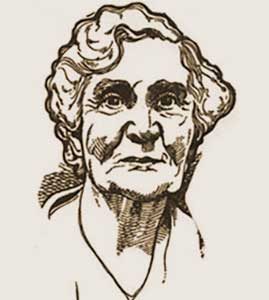LIBBIE CONOVER BOOTH
The information below has been compiled from a variety of sources. If the reader has access to information that can be documented and that will correct or add to this woman’s biographical information, please contact the Nevada Women’s History Project.

Lew Hymers
At A Glance:
Born: April 12, 1856, Monterey, California
Died: June 27, 1948, San Jose, California
maiden name: Mary Elizabeth Conover
Race/Nationality/Ethnic Background: Caucasian
Married: George A. Booth, April 12, 1874
Children: None
Primary City and County of Residence and Work:
Reno, Washoe County, Nevada
Major Fields of Work: Educator, Teacher and Principal.
Other Role Indentities: Libby Booth Elementary School, Reno, Nevada, was named in her honor.
Washoe County has named 31** schools after early women educators. Sadly, some of the schools are now gone and with them the memories of those women who dedicated their lives to the pursuit of educating Reno’s youth. These ladies and their contributions to the Reno/Sparks communities should not be forgotten.
It is not common for a woman to have a school named after her and also have her educational virtues extolled in minutes of the United States Senate. This is the biography of an extraordinary woman, honored by the naming of an elementary school for her. Still in existence and actively engaged in educating students, Libby Booth Elementary School unfortunately also still bears the misspelling of her first name.
Mary Elizabeth Conover, born April 12, 1856, grew up in the Monterey, California area with four siblings. She was the daughter of merchant Simpson Conover and Henrietta Bartman Conover, who died when Libbie was nine.
Libbie Conover began her teaching career at the age of 15 in nearby Hollister, California, in 1873. Eleven of her first students were older than she. On her 18th birthday in 1874, she married brick mason George Booth. She continued to pursue her academic proficiency credentials while teaching, and earned her California Life Teaching Certificate in 1885. This certificate was also honored by the State of Nevada where, three years later in 1888, the couple moved to Reno. Libbie immediately obtained a teaching position there while George engaged in the brick and contracting professions.
At the time Booth was hired, Reno had only one school and a staff of nine teachers. For many years she taught at the Central School. In 1904 she left that school to teach at South Side School.
Her Nevada State Journal obituary (6-29-1948) states:
“She left the public school system for a time in 1908 when she was principal of Whitaker’s seminary which was then operating here.”
The Journal statement is incorrect and deserves explanation.
Whitaker Women’s Seminary, later referred to as the Whitaker School, closed its doors in 1894. It, then, had several owners and uses over the years. The Whitaker seminary building was called back into service in February 1907 when the Reno School Trustees closed the “Manning” school building for unsanitary and unsafe conditions, and moved 80 eighth graders to the old Whitaker seminary building in northwest Reno. Booth was a teacher at the Whitaker School in 1907-08 and Southside School in 1908-09. She became a principal at Whitaker in 1909-10. Never did she leave the Reno public school system.
Libbie Booth was involved in the planning and then was appointed to the position of principal at the newly constructed Orvis Ring School in the fall 1910. This was one of the four picturesque Spanish Style schools Reno built between the years of 1909-1912. She remained in that position for the next 25 years and was instrumental in not only the naming of that school, but also the Mary S. Doten School (1912). Both of those individuals had been her early teaching peers.
1917 saw Libbie Booth and staff member Jennie Logan start the Orvis Ring Pet Parade, a tradition that remained a popular Reno community activity well into the mid-1970s. Each fall students paraded down Virginia Street with their costumed pet animals in tow down to Powning Park where booths had been set up for the traditional spaghetti feed and games. Some of the money generated from this fundraiser was used for upgrading school playground equipment and the purchase of new technology, such as movie cameras and projectors. However, the fundraising also had a more serious component. Well aware of the needs of some of their less fortunate students, the two founders allocated some of the profits towards one of the first school district hot lunch programs. A fund dedicated to aiding needy children and their families was also financed.
Booth twice served as a representative to the National Education Association (NEA) conventions and was a two-time appointee to the post of Nevada State NEA director. In recognition of her teaching service, she was awarded the “American Youth and American Teacher Award” at the Philadelphia Sesqui-Centennial Exposition in 1926. She was selected for this honor by a group of Nevadans as the teacher who had, “accomplished the greatest good for the greatest number of pupils of her state.” After accepting this award in Philadelphia, she traveled to Washington, D.C. to receive her medal and meet with President Calvin Coolidge at the White House.
Libbie Booth’s activism extended into the community as well as to her profession. She initially joined the Hollister, California, Athena Chapter of Eastern Star and transferred to Reno’s Ada chapter soon after moving to the community. In addition to serving in the highest offices of both of those chapters, she served one year as the Grand Chaplain of the Grand Chapter of Nevada. She also filled the position of Acting Worthy Grand Matron when the Martha chapter of Wadsworth, Nevada, was instituted in 1906. This chapter was later moved to Sparks. Other major areas of her civic involvement included being an active member of the Trinity Episcopal Church and one of the founders, past president and lifetime member of the Reno Twentieth Century Women’s Club.
Senator Pat McCarran, on the eve of his election to Congress in 1933, wired Libbie Booth, his former teacher: ”I have been elected United States Senator. For all the honors that come to me, I am indebted to you for your good and careful training and guidance in the years when my life was in the making.” He not only acknowledged his gratitude to her by telegraph message, but he also included his admiration for his former teacher in remarks read into the U.S. Congressional Record. She was quite proud of this honor and rightly so. One of Mrs. Booth’s former students described her as, “no nonsense. Strict but fair.”
In a tribute paid to Libbie Booth upon her retirement, it was said that she had an almost unbroken record of attendance at Orvis Ring and perhaps a little-known fact about this dedicated educator best illustrates her passion to education. For many years Booth tutored Reno’s academically talented boys for their West Point and Annapolis military entrance exams, but she also taught “Americanization” (citizenship) classes to Reno’s immigrant population in their quest to obtain U.S. citizenship.
Although Libbie Booth officially retired in 1935, she remained involved in many educational and civic affairs until her health became a factor. Husband George had previously died in 1907 and they had no children of their own. In 1944, and in ill health, she moved to San Jose, California, to be closer to extended family members. Libbie died on June 27, 1948. Her body was returned to Reno to be buried beside her husband in Reno’s Mountain View Cemetery.
The Washoe County School District named a school after Libbie Booth in 1955. The Libby Booth Elementary School remains a vibrant center of student learning to this day. Although, unbelievably, the school district misspelled her first name, that tangible honor to her memory still successfully carries on her lifetime commitment of educating Reno’s youth to the best of their abilities. Booth Street, which runs between Reno High School and the Federal Building in southwest Reno, was also named after Libbie Booth in 1949.
In 1936 the Nevada State Journal described Libbie Booth as having, “executed her duties with the firm dispatch of an unquenchable spirit and there are those who say she has whipped a rowdy boy on occasion; kept perfect discipline in the schoolroom and always carried herself with the vivacity of youth, which she still does.” This article continues, “Her heart will always be with the youth of America.” Although she and most of her former students have passed on, her life’s passion continues to mold future generations. What a wonderful legacy!
Researched and written by Patti Bernard. September 2008, revised January 2019
* See paragraph 3.
** This figure does not include the Rose M. Bullis Curriculum and Instruction Center (formerly known as Brown Elementary School) which was renamed in her honor when a new Brown Elementary school was built and the curriculum program moved into the old school. That building has since been again renamed the Brown Center (2006). The Rose Bullis Curriculum and Instruction Center was moved to a different facility which does not bear her name.
Sources of Information:
- “Mrs. Libbie Conover Booth.” Nevada State Journal (Reno, Nevada), April 15, 1926.
- “Mrs. Booth Receives Gold Award For Service to Youth of State.” Nevada State Journal, (Reno, Nevada), May 3, 1936, p. 12:1.
- “16th Pet Show to be Saturday.” Reno Evening Gazette (Reno, Nevada), September 17, 1936, p.3:3.
- “Society.” Reno Evening Gazette (Reno, Nevada), September 24, 1937, p 14:2.
- “Libbie C. Booth Dies at Age of 95.” Reno Evening Gazette (Reno, Nevada), June 28, 1948, p. 1:4.
- “Libbie Booth – Old-time Reno Teacher Dies.” Nevada State Journal (Reno, Nevada), June 29, 1948, p. 16:2.
- “Mrs. Libbie C. Booth”, Reno Evening Gazette (Reno, Nevada), June 29, 1943, p. 6:2.
- “Her Life’s Work.” Nevada State Journal, (Reno, Nevada), June 29, 1948, p. 4:1.
- “Many Pets Seen During March.” Reno Evening Gazette, (Reno, Nevada), September 25, 1949.
- “Foster’s Name Is Bestowed on Reno Stadium”. Reno Evening Gazette Reno, Nevada), December 29, 1948. p. 14.1.
- “Libby Conover Booth.” Rose Bullis Manuscript Collection. Nevada Historical Society, Reno, Nevada, Undated Manuscript.
- “Libby C. Booth School, Scripts from Nevada’s Centennial show.” Rose Bullis Manuscript Collection MC 784, Nevada Historical Society, Reno, Nevada, 1964.
- “Bishop Whitaker’s School for Girls.” Nevada Historical Society Quarterly, XIX (fall, 1976), pp. 170-184.
- Bishop Abiel Leonard file, Whitaker Seminary notes, Nevada Historical Society, Reno, Nevada.
- Deed Records, Washoe County, Book 37, October 30, 1909, p. 220.
- Deed Records, Washoe County, Book 62, December 11, 1922, p. 35-36.
- Interview and correspondence: Carr, Majorie M., Past Grand Matron of Nevada, O.E.S.
- Interview: McDonough, Robert E., March 18, 2008, Reno, Nevada.
- Rocha, Guy. “Memo to Patti”. Mar. 13, 2008.
- Ancestry.com. Year: 1860; Census Place: Monterey, Monterey, California; Roll: M653_60; Page: 926; Image: 390; Family History Film: 803060. [Mary E. Conover]
- Ibid. Year 1870; Census Place: Watsonville, Santa Cruz, California; Roll: M593_89; Page: 375B; Image 275. [Libbie Conover]
- Ibid. Year 1880: Census Place: Hollister, San Bonito, California; Roll: 72, Family History Film: 1254072; Page: 393A; Enumeration District: 060; Image. 0007. [Libbie Booth]
- Ibid. Year: 1900; Census Place: Reno, Washoe, Nevada; Roll 623_943; Page: 10A; Enumeration District: 42. [Libbie C. Booth]
- Ibid. Year 1910; Census Place: Reno Ward 5, Washoe, Nevada; Roll 624_859; Page: 2B; Enumeration District: 72; Image: 982. [Libbie C. Booth]
- Ibid. Year: 1920; Census Place: Reno, Washoe, Nevada; Roll: T625_1005; Page: 2B; Enumeration District: 52; Image 273. [Mary Elizabeth Booth]
- Ibid. Year: 1930; Census Place: Reno, Washoe, Nevada; Roll: 1297; Page: 2A; Enumeration District: 12; Image: 751.0. [Libbie B. Booth]
- Ibid. Year: 1940; Census Place: Pacific Grove, Monterey, California; Roll: T627_268; Page: 81A; Enumeration District: 27-47. [Sibby Booth]

